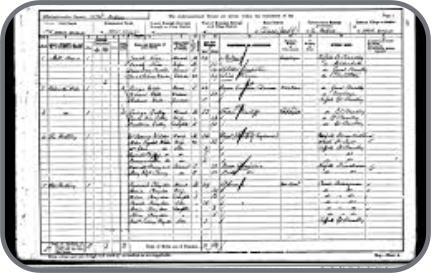

© Avening Parish Council 2020
“Preserve, Conserve, Enhance”


14 Frank Locke
Private: 5th Battalion Gloucestershire Regiment Frank missed the 1891 census by just a few weeks but his three elder brothers and one sister were included, living with father, John Locke (born Avening 1862) and mother Jane (née Milsom) born the same year at Tresham, near Hawkesbury. Frank was born at Crackstone as was his younger sister, Annie. His paternal family history is solidly of Avening and from our records now held in the church, we can trace his ancestry with Samuel Brown (born 1765), Sarah Ind (baptised 1772) and William Dee (baptised 1767) among his 32 three- times great grandparents. Frank entered the First World War in 1915 as another of Avening's Kitchener’s New Army but did not arrive in France until the following year. We catch up with him in early July 1916 at the outbreak of the Battle of the Somme. The early part of that battle proved disastrous in our losses, mainly due to observation by enemy troops from the higher ground in the region, which, although not particularly high, gave them the means to direct their artillery and also warn their entrenched forces of our advances. Part of this high ground included the village of Pozières and it was decided that Pozières and its surrounding high ground would be taken. The main attack was scheduled for the night of 22/23 of July and two Australian divisions were tasked to attack from the south of the village, whilst being supported by the 145th Brigade, part of the 48th (South Midlands) Division, that brigade including the 5th Battalion Glosters. The weather was fine on that Saturday/Sunday night and the attack on the German trenches was preceded by the usual artillery bombardment. At 35 minutes past midnight the Glosters advanced with the 4th Battalion Oxford and Bucks Light Infantry on their right. Despite it being dark, the attack was quickly discovered by the enemy who were holding their trenches in some strength. Heavy artillery and machine-gun fire fell upon our troops and, despite reinforcements being brought up, the objectives could not be reached. The battle went on for over three hours at which time the Glosters were withdrawn to the reserve trenches, being replaced by men of the Berkshire Regiment. Later that morning the Germans had retreated. In the attack the Glosters had lost 150 men killed, missing or wounded, Frank Locke being one of the twelve killed. Meanwhile, the Australians had eventually taken the main village of Pozières but only suffering terrible losses. Even today, their contribution remains legendary in Pozières history. Frank is buried at the Pozières British Cemetery, the next grave to him being that of a 21 year old man from Oxford. He was awarded the Victory Medal and the British Medal, both of which would have been presented to his parents at the end of hostilities. He was 25 years old and unmarried. We have been unable to locate any near relatives.
AveningHistory pages
WW1 Heroes


© Avening Parish Council 2020
ABOUT
Avening History pages
The Medieval Village of Avening has a rich and varied past - it grew around the Norman Church of the Holy Rood (or Holy Cross), which was built on the site of an earlier Saxon Church. It is said to have been built in 1080, being the only church ever to be built by a Queen of England. During the Second World War, Avening lay on GHQ Line. Extensive anti-tank ditches were constructed to the south and southeast, and were overlooked by a number of pillboxes. The defences were constructed as a part of British anti-invasion preparations.

AveningHistory pages


Census information - 1841 to 1911
We have transposed the census information from 1841 to 1911, so that you are able to search and download all of the records to help with your family trees or general research. You will find guidance notes, a searchable index, and the full record for each census.

Avening in the First World War
In Avening Parish Church, the Roll of Honour shows that the village lost 42 men in the First World War. Many of the family names can still be found among the current inhabitants of Avening. Military records list a total of 87 men serving in the forces during the first year of the war. This was from a total population of 823 in 1914. The hamlet of Nag’s Head alone sent 17 men from only 18 houses. Most of the men served in the Gloucestershire Regiment; some were in other regiments or the Royal Navy. One Baptist minister, the Reverend Edward Fowles, who had been working as a missionary in China, was enlisted as an officer in the Chinese Labour Battalions in France because of his knowledge of Chinese customs and language. Avening men fought in nearly all the theatres of the war, from Flanders to Mesopotamia. Those who died were killed in action or fatally wounded at Ypres, Loos, Cambrai, Arras, the Dardanelles and many other places. Some were decorated for their bravery, with at least three Military Medals and two Distinguished Conduct Medals being awarded to local men. Click on the WW1 Heroes link to read the stories of the 42 men who died in the conflict



Avening places
Historic pictures and views of the village showing the changes that have happened in the development of Avening

Avening people
Looking at the charactors and people who have lived in Avening







- HOME
- Councillors
- Agends and Minutes
- Finances
- Contact
- Info for New Residents
- Villager Archive
- Avening Community
- Walks Around Avening
- History Home
- News
- Gallery
- the cafe page
- census information
- ww1 heroes
- 1 Frederick R POLLOCK
- 2 Frederick J Fletcher
- 3 William C Richings
- 4 Herbert J Bridgeman
- 5 Martin Viner Pollock
- 6 Richard Ayres
- 7 Hubert Vivian Ind
- 8 Charles Wm. Fletcher
- 9 Charles Smith
- 10 Samuel Fletcher
- 11 Ralph John Dee
- 12 George Newman
- 13 Jesse William Robins
- 13 Jesse william robins-a
- 15 Albert Harry Cuff
- 16 Ernest Cooke
- 17 Arthur Charles
- 18 Albert Ayres
- 19 Percy Sharp
- 22 George John
- 20 Joshua Albert Ford
- 21 Alfred William Risby
- 23 William Freeman
- 24 Arthur George King
- 25 Samuel Luker
- 26 George Hill
- 27 Hubert Charles Ayres
- 28 Albert Henry Chipp
- 29 Rowland Fowles
- 30 Augustus Clapton
- 31 Harold Henry Newman
- 32 Charles Nurding
- 33 Charles Eldridge
- 34 Frederick Townsend
- 35 Percy Lynn Hill
- 36 Frederick Tanner
- 37 George Dickerson
- 38 Charles Barnet Payne
- 39 Adolphus W Sharp
- 40 George Hicks
- 41 Walter Ind
- 42 William George Tanner





















